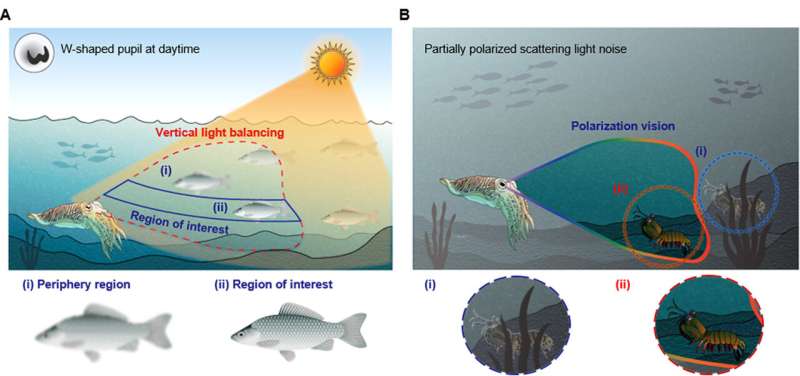Optical features of cuttlefish living in the underwater environment. Credit: Kim et al., Sci. Robot. 8, eade4698 (2023)
A team of roboticists from Seoul National University, Gwangju Institute of Science and Technology and Pusan National University, all in the Republic of Korea, has developed a new kind of robotic eye that can see better under uneven illumination conditions. In their paper published in the journal Science Robotics the group describes using attributes of cuttlefish as a template for their new design.
Cuttlefish are marine mollusks in the same class as cephalopods, which includes octopuses and squid. They have eight arms, two tentacles, denticulated suckers and W-shaped pupils. Prior research has shown that the unique pupil shape helps the creatures to see in murky or unevenly illuminated conditions. In this new effort, the researchers used the W shape of the cuttlefish eye as a template for creating a new kind of robotic eye that would work better in poorly lit environments than those that are currently used in most robots.
To create the robot eye, the engineers created a W-shaped pupil and attached it to a ball-shaped lens, along with an aperture separating the two. They also added flexible polarizing material to the inside surface of the eye and an array of cylindrical silicon photodiodes for use in converting photons into electrical signals. The team then tested the new design to compare it with current robot eye technology, which is generally based on general-use cameras.
Object detection of the cuttlefish-eye-inspired artificial vision system. Credit: Kim et al., Sci. Robot. 8, eade4698 (2023)
They found that the new design detected more details on a test photo than was possible with other robot eyes. They also found that it was more accurate in converting the outlines of dimly lit objects to real world estimates than regular robot eyes.
The researchers suggest their new design is an initial step toward creating robot eyes that are better at dealing with low light or murky conditions and also for dealing with blind spots. Such a robot eye, they note, would be particularly useful on roving robots or even on cars. They plan to continue their work by first looking for ways to replace the expensive components they used with less expensive technology and by adding a tracking capability.
More information: Minsung Kim et al, Cuttlefish eye–inspired artificial vision for high-quality imaging under uneven illumination conditions, Science Robotics (2023). DOI: 10.1126/scirobotics.ade4698
Journal information: Science Robotics
© 2023 Science X Network
























